So when a more world-cuisine-savvy friend of mine pointed out that all pasta, no matter the shape or size, were made from durum wheat (with minor variations like the addition of egg or spinach), I was terribly disappointed.
“You mean they all have different names and look different but are made from the same ingredients?" I asked disbelievingly.
"Yes," he said, uncompromisingly.
"Are you quite sure? They're all made from the same ingredients?” I asked for the second time in as many minutes, unwilling to let go of my illusion that each had its own taste.
“Yes, quite sure,” he said again, unable to figure out why I sounded so let-down.
I persisted with my questioning even in the face of his blunt reply. “Then they all taste the same? Just the sauces are different? All the cooked pasta have the same bland taste?"
“YES,” he said, again uncompromisingly but this time with an added edge of irritation.
“But then what’s the POINT?” I wailed.
“What do you mean, what’s the point?” Full-on exasperation, there.
“What’s the POINT of having different shapes if it’s all just the same damn thing? What’s the big deal about pasta then? It’s really the sauce that matters, not the pasta itself.”
And that was when I got the lecture about diff’rent strokes for diff’rent folks, to use a phrase not coined by me in a context probably totally unlike the original coining.
Although I eventually learnt to accept that all pasta may just be pasta but none of them are JUST pasta, still in my heart of hearts there lingers the faint echo of my original outburst... “But what’s the big deal about pasta, then?”
On the other hand, I’ve had people say to me, on being informed that South Indian cuisine is based predominantly around rice with different “sauces” (sambar, rasam, kootu, etc) to flavour it: “But rice is just like pasta then, isn’t it?”
It has been only with the greatest reluctance that I could bring myself to admit that yes, in that ONE way rice IS like pasta... but it’s also so very much MORE than pasta! Different varieties of rice, when cooked, taste and smell different and have different textures. I’m guessing that it’s only of late that scientists have been “inventing” new varieties of rice – but even that is only reinvention (using Nature’s bounty) at best, or tampering (with Nature’s bounty) at worst.
Pasta, on the other hand, completely an artificial invention (seen any pasta fields lately, folks?), has no distinguishing natural characteristics by way of shape or size (beyond those created by humans) or taste (beyond the “taste” of the sauce in which it is dunked).
So, bottomline - no, pasta is most definitely not like rice.
However, over the years, I’ve quite learnt to like pasta and I do understand about the shapes and sizes and uses.
Here’s a recipe with one of each – size, shape and use.
Recipe for: Pasta with rocket (arugula) pesto

Ingredients:
Whole-wheat pasta - orecchiette or conchigliette for choice, but penne or farfalle will do
4 cups rocket (arugula), washed and patted dry
1/4 cup fresh basil leaves

3-4 cloves of garlic
1 tbsp fresh lemon juice
3/4 cup pine nuts (can substitute walnuts)
About 1/4 cup good quality extra virgin olive oil
1/3 cup sundried tomatoes in oil, well drained
Salt and pepper to taste
Grated or shaved Parmigiano reggiano for garnish
Method:
1. Toast the pine nuts in a skillet till golden brown, taking care not to burn them. Set aside to cool.

2. In a food processor or mixie, add half the toasted pine nuts (reserving the other half), garlic, rocket (arugula) leaves and basil. Squeeze or pour the lemon juice over the leaves.

3. Now add olive oil little by little, as required, to help grind the leaves and nuts smoothly.

You might not need to use all the olive oil, just use as much as required.
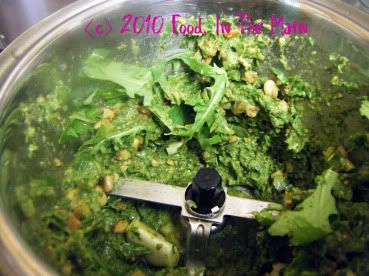
4. When the ingredients have been ground up into a fairly smooth pesto, remove the pesto to a bowl.

5. Add plenty of pepper and salt to taste.
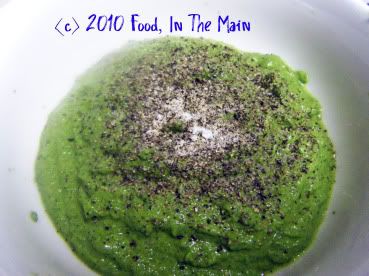
6. Cook the pasta till al dente in plenty of salted water, and drain off the water when the pasta is done. Return the pasta to the pan.
7. Slice the drained sundried tomatoes thinly.
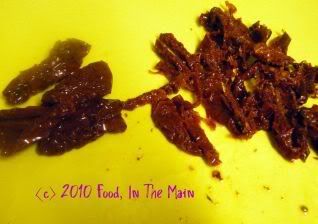
8. Add 3-4 tbsp of the pesto to the pasta and mix in thoroughly. Taste for seasoning and add more pesto if required, making sure that every bit of the pasta is covered.
Add the sliced sundried tomatoes and stir them in,
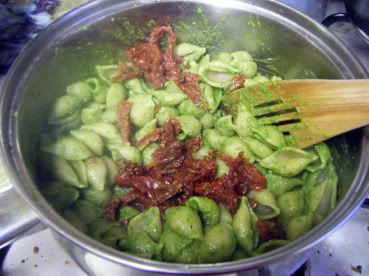
then add the reserved toasted pine nuts. Toss or stir the pasta to distribute the pine nuts evenly.
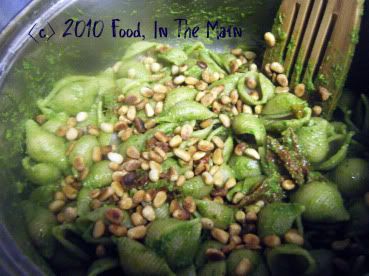
9. Serve the pasta in warmed bowls with generous shavings or gratings of parmigiano reggiano as garnish.


7 comments:
yummy.love the step by step description..
LOL. Hilarious post!
I love how you write! :) Okay oru question: Arugula is not kasapu?
Hi Shammi, hope you're well!
I once read that orecchiette means "little ears" -- wonder if that is true. I've never tried pesto using arugula, or with the sun-dried tomatoes for that matter. At any rate, it looks like a perfect marriage :)
This looks really awesome! I love that color. I made a huge batch to freeze in my commercial food processor that I got from this restaurant equipment store online. It holds 12 cups so I probably made too much!
J: Thanks! :)
A & N: Arugula is faintly kasappu as leaves, but no kasappu as pesto from what I could tell. :)
Linda: Orecchiette DOES mean "little ears" :) I liked the shell-type I used because the pine nuts went and hid inside them! :)
Elana: 12 cups seems just a tad too much :D
That pasta looks amazing! I only recently tried arugula in a salad and it was bitter.. doesn't that interfere with the pasta taste?
I so agree that rice is so much more than pasta.. as far as pasta fields go - apparently lots of people got fooled with this
http://news.bbc.co.uk/onthisday/hi/dates/stories/april/1/newsid_2819000/2819261.stm
Inji: The arugula pesto wasnt bitter at all - perhaps because of the other ingredients in it.
The people who got fooled were obviously pasta virgins :D
Post a Comment